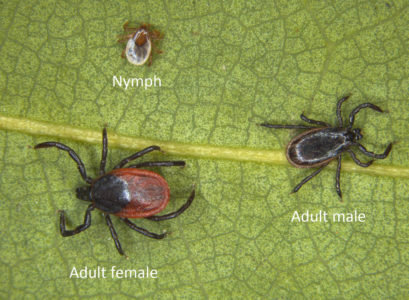Posted On:
Category: Category:
What Attracts Fleas and Ticks to My Pets During the Summer on Long Island
What Attracts Fleas and Ticks to My Pets During the Summer on Long Island
Your pet’s soft fur creates the perfect environment for fleas and ticks. Fleas and ticks dwell in the same area that your canine plays, including your backyard, the dog park, and along the pathways you take he/she for walks. Fleas and ticks hang out in the grass, shrubs, bushes, and trees and thrive anywhere that has a lot of shade and moisture. When a warm body walks by, these blood-sucking parasites smell a feast and latch on. Fleas are capable of jumping up to a foot in the air vertically to gain access to your pet. And ticks can latch onto your beloved furball for up to five days without your furry best friend even knowing.
Think your cat is safe because you keep them indoors? Think again. Fleas are small enough to get through even the smallest hole in your screen. So, when your precious kitty is sitting on the windowsill enjoying the view, he/she may be attracting fleas unknowingly. Those who share their homes with dogs are even more prone since these hateful creatures can jump from one animal to the next. When a flea jumps onto your pet, it starts feeding within five minutes and may suck its blood for up to two hours. One single flea can live on your dog or cat for up to two months!
The Dangers of Ticks to Your Pet
Let’s start with the dangers of ticks. Like humans, dogs and cats are prone to certain diseases that ticks carry. Some diseases only affect one or the other, but here is a list of the most common conditions to watch out for:
Lyme disease
Carried by the deer tick, Lyme disease is seen more frequently in dogs than cats, however, it is possible for a cat to get the disease. If a cat is infected, it can affect its kidneys, joints, and nervous system. Symptoms in canines include a rash around the tick bite, fever, fatigue, and loss of appetite.
Rocky Mountain Spotted Fever
Commonly seen in dogs, symptoms include lethargy, stomach pain, and vomiting. If not treated promptly, it can become fatal.
Ehrlichiosis
Only seen in dogs, symptoms include fever, fatigue, loss of appetite, lymph node enlargement, and abnormal bruising.
Haemobartonellosis
In cats, this condition is known as feline infectious anemia. It attacks the red blood cells, which leads to anemia and weakness. While it affects both cats and dogs, the disease does not usually manifest itself in dogs unless your pup already has underlying issues.
Tularemia
Cats are more prone to tularemia, and when contracted, it gives them high fever, swollen lymph nodes, nasal discharge, and possible abscesses. If infected, dogs can exhibit reduced appetite, depression, and a mild fever.
Cytauxzoonosis
This medical-sounding term is found only in cats. Symptoms include anemia, depression, high fever, difficulty breathing, and jaundice. Depending upon the age and health of your cat, death can occur in as short as one week. Cats who do survive carry this disease for life.
Babesiosis
Ticks transmit this disease to your pooch through tiny single-celled organisms that attach themselves to their red blood cells. This dangerous condition can be severe and cause fever, depression, swollen lymph nodes, pale gums, and depression. In severe cases, the dog may collapse and go into sudden shock.
The Danger of Fleas to Your Pet
Here are some of the most common reasons fleas are such a problem for our best friends:
- Flea infestations can quickly get out of control because a female flea can produce up to 2,000 eggs in one lifetime.
- Fleas can consume 15 times their body weight in blood, which can cause anemia or significant blood loss for small or young pets. Signs of anemia caused by fleas include pale gums and lack of energy.
- Some pets can develop severe allergic reactions to flea saliva called Flea Allergy Dermatitis. Symptoms include intense itching, hair loss, scabs, and red, irritated skin, leading to skin infections. The itching can last well after the fleas are gone.
- Fleas are responsible for transmitting tapeworm to pets if a flea is ingested. And let’s face it, as gross as that may sound, our dogs and cats will eat anything. The tapeworm is initially inside the flea and gets passed onto the pet when ingested. Tapeworms are parasites that cause an itchy rear end as well as weight loss. Fortunately, it’s easily treated by the veterinarian.
- Fleas lay eggs that drop out of your pet’s fur and inside your home, burying in your rug, upholstery, bedding, and furniture. Once hatched, the new fleas will seek out a new living host.
Signs My Pet Has Fleas or Ticks
The first thing you will notice is that your cat or dog will be scratching. If you have more than one dog, you may see fleas jumping from canine to canine, or you may see specks of flea remnants around your house. Other signs include:
- Your pet is scratching or biting at their fur.
- Red bumps or pimples may appear on their skin.
- You can see the little buggers. They are tiny, but you may catch them hopping around between the fur since they can jump.
- Remnants found on your pet’s skin, carpet, your pet’s bedding, their favorite toy, or chair. These specks look like bits of dried blood.
Prevention of Fleas and Ticks
There are various ways you can help prevent your best friends from getting fleas and ticks. One way is to keep your lawn mowed and well-manicured since this is where fleas and ticks hide out. Also, take time to regularly inspect your canine after he/she has been outside in the yard or you’ve taken them for a walk. If you find a tick, the faster you remove it, the less likely they are to contract an illness. And speak to your veterinarian to find the best, appropriate flea and tick product for your pet. There are tons of effective flea and tick topical treatments, collars, and shampoos on the market.










